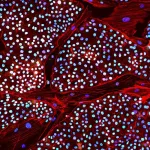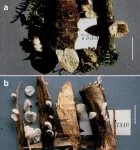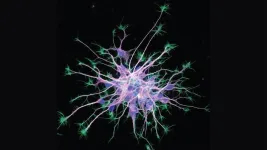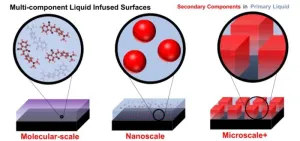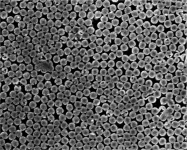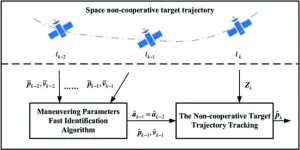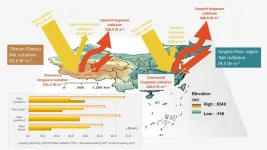(Press-News.org) Dallas, TX – March 06, 2024 - Colossal Biosciences (“Colossal”), the world’s first de-extinction company, announces today that their Woolly Mammoth team has achieved a global-first iPSC (induced pluripotent stem cells) breakthrough. This milestone advancement was one of the primary early goals of the mammoth project, and supports the feasibility of future multiplex ex utero mammoth gestation.
iPSC cells represent a single cell source that can propagate indefinitely and give rise to every other type of cell in a body. As such, the progress with elephant iPSCs extends far beyond this de-extinction project holding tremendous potential for studying cell development, cell therapy, drug screening, synthetic embryos, in vitro gametogenesis, and the use of iPSCs for nuclear transfer across all species. Invaluable for Colossal’s Woolly Mammoths, these cells can be multiplex-edited and differentiated to study cold adaptation traits like woolly hair growth and fat storage in cellular and organoid models.
“In the past, a multitude of attempts to generate elephant iPSCs have not been fruitful. Elephants are a very special species, and we have only just begun to scratch the surface of their fundamental biology,” shared Eriona Hysolli, Head of Biological Sciences at Colossal Biosciences. “My early work in Dr. George Church’s laboratory had been partially successful with iPSC-like cells that led to the foundation of the cells we have currently developed. And now, using a multi-pronged approach to reprogramming we have the most successful efforts to date. The Colossal mammoth team persisted quite successfully as this progress is invaluable for the future of elephant assisted reproductive technologies, as well as advanced cellular modeling of mammoth phenotypes.”
The derivation of mouse iPSCs pioneered by Shinya Yamanaka in 2006 paved the way for using a 4-factor protocol to derive human, horse, pig, cattle, rabbit, monkey, ape, big cats, rhino and even avian species iPSCs among many more. While the medium where the cells grew required some tweaking depending on the species, it was surprising to observe how close to universal the reprogramming protocol was across species. Yet, elephant iPSCs still remained elusive.
“Elephants might get the "hardest to reprogram" prize, but learning how to do it anyway will help many other studies, especially on endangered species. This milestone gives us insights into developmental biology and the balance between senescence and cancer. It opens the door for obtaining gametes and other cell types without surgery on precious animals. It opens the door to establishing connections between genes and traits for both modern and extinct relatives – including resistance to environmental extremes and pathogens. This collaboration has been a true pleasure and a colossal accelerant for our challenging project,” shared Colossal co-founder and renowned Harvard geneticist Dr. George Church.
Using chemical-based induction media first, followed by addition of transcription factors Oct4, Sox2, Klf4, Myc +/- Nanog and Lin28, and p53 pathway suppression, the team has achieved the most successful reprogramming of elephant iPSCs yet. The approach differs from other more standard reprogramming protocols for other species due in part to the complexities of the TP53 pathway in elephants as their genome contains up to 19 copies of TP53 retrogenes. TP53 is a core gene utilized by the cell to carefully regulate its growth so as not to become cancerous. Additionally, reprogramming, which in itself is quite long and inefficient for higher mammal species, takes longer for elephants. But, the successful iPSC cells now express multiple core pluripotency factors and are able to differentiate into the three germ layers that have the potential to give rise to each cell type in the body.
These newly reprogrammed iPSC cells have been validated through immunostaining, PCR of pluripotency and differentiation markers, transcriptomics analysis, embryoid bodies and teratoma formation. This work will be published in Bioarxiv with a peer-reviewed article in a scientific journal in progress. It is not the end of the elephant reprogramming journey, but this announcement marks the first successful steps. The mammoth stem cell team with team lead Evan Appleton are now focused on further maturing these cells, and pursuing additional iPSC generation strategies that have so far also been successful. This work will be shared in follow-up publications.
“We are most excited to use the cells we have developed to grow elephant gametes in a dish. While elephants have been a challenging species, this has been an incredibly unique opportunity with so much to learn and share now and in the near future,” shared team lead Evan Appleton.
“We knew when we set out on the Woolly Mammoth de-extinction project that it would be challenging but we’ve always had the best team on the planet focused on the task at hand,” stated co-founder and CEO of Colossal, Ben Lamm. “This is a momentous step, with numerous applications, that we are proud to share with the scientific community. Each step brings us closer to our long term goals of bringing back this iconic species.”
The team is also working to establish a mechanism that can explain why elephant cell reprogramming has been challenging. Doing so is critical to deriving iPSCs faster, achieving more advanced tri-lineage differentiation, particularly in vitro gametogenesis, which is crucial to test the full potential of the iPSCs. Once the iPSCs can be used to establish a model for synthetic elephant embryos, it will also be integral to understanding the long and complex elephant (and by association mammoth) development and gestation cycle. This will be critical to Colossals’ re-wilding efforts which rely heavily on leveraging ex utero development for species preservation and restoration. All of these scientific developments hold extension possibilities across the field of developmental biology which have ramifications far beyond the current Colossal projects.
ABOUT COLOSSAL
Colossal was founded by emerging technology and software entrepreneur Ben Lamm and world-renowned geneticist and serial biotech entrepreneur George Church, Ph.D., and is the first to apply CRISPR technology for the purposes of species de-extinction. Colossal creates innovative technologies for species restoration, critically endangered species protection and the repopulation of critical ecosystems that support the continuation of life on Earth. Colossal is accepting humanity's duty to restore Earth to a healthier state, while also solving for the future economies and biological necessities of the human condition through cutting-edge science and technologies. To follow along, please visit: www.colossal.com
WEBSITE & SOCIALS
Websites: www.colossal.com
Twitter: https://twitter.com/itiscolossal
Instagram: https://www.instagram.com/itiscolossal/
LinkedIn: https://www.linkedin.com/company/itiscolossal/
Facebook: https://www.facebook.com/itiscolossal
Hashtag: #itiscolossal
COLOSSAL PRESS CONTACTS:
R&CPMK / Emily.mailaender@rcpmk.com
Prosek / pro-colossal@prosek.com
END
Revolutionary elephant iPSC milestone reached in Colossal’s Woolly Mammoth Project
Colossal scientists achieve global first; technology promises seminal advancements for engineering Woolly Mammoth phenotypes in in vitro cellular models, developmental biology, and attaining balance between senescence and cell growth
2024-03-06
ELSE PRESS RELEASES FROM THIS DATE:
JAMA study finds facilities treating poor patients penalized by CMS payment model
2024-03-06
INDIANAPOLIS – A new study of more than 2,000 dialysis facilities randomized to a new Medicare payment model aimed to improve outcomes for patients with end-stage kidney disease has found that facilities that disproportionately serve populations with high social risk have lower use of home dialysis and transplant waitlisting and fewer kidney transplants. These facilities thus received reduced performance scores and reimbursement from Medicare.
A high proportion of non-Hispanic Blacks and of those initiating dialysis while uninsured or Medicaid-covered also was found to be an indicator of lower use of home dialysis and transplant waitlisting and fewer kidney ...
For Boston College professor, research into "high latitude" reaches of the seas led to improving accurate access to real-time ocean data
2024-03-06
Chestnut Hill, Mass (03/06/2024) – Boston College Assistant Professor of Earth and Environmental Sciences Hilary Palevsky has been awarded a nearly $1-million National Science Foundation CAREER Award for her work to make remote ocean monitoring data accessible and accurate in real time and produce a series of educational videos to guide students using the data.
Palevsky, whose research focuses on marine biogeochemistry and the mechanisms that enable the ocean to absorb carbon dioxide from the atmosphere, said the funding will allow her to build upon the work she has done to help scientists use the ...
Microbes impact coral bleaching susceptibility, new study shows
2024-03-06
Washington, D.C. – March 6, 2024 – A new study provides insights into the role of microbes and their interaction as drivers of interspecific differences in coral thermal bleaching. The study was published this week in Applied and Environmental Microbiology, a journal of the American Society for Microbiology.
“The diversity, community dynamic and interaction of coral associated microorganisms play important roles in the health state and climate change response pattern of coral reefs,” said lead study author Biao ...
Study: Black boys are less likely to be identified for special education when matched with Black teachers
2024-03-06
WASHINGTON, March 6, 2024—Black male elementary school students matched to Black teachers are less likely to be identified for special education services, according to new research published today. The relationship is strongest for economically disadvantaged students. The study, by Cassandra Hart at the University of California, Davis, and Constance Lindsay at the University of North Carolina at Chapel Hill appeared in the American Educational Research Journal, a peer-reviewed journal of the American Educational Research Association.
The researchers also found that the connection is ...
A new genus of fungi on grasses
2024-03-06
While ecologically important, small mushrooms on monocots (grasses and sedges) are rarely studied and a lack of information about their habitat and DNA sequences creates difficulties in determining their presence or absence in ecological studies and their genetic relationships to other mushroom taxa.
This study led by Drs. Karen W. Hughes and Ronald H. Petersen (University of Tennessee, Knoxville, TN, USA) examined a mushroom species, Campanella subdendrophora, (also known as Tetrapyrgos subdendrophora), which fruits on grasses in the US Pacific Northwest.
The researchers evaluated its phylogenetic position concerning both Campanella and Tetrapyrgos ...
Allen Institute joins the Weill Neurohub
2024-03-06
SEATTLE, WASH.—March 6, 2024—The Allen Institute has officially become the newest member of the Weill Neurohub, a collaborative research network advancing treatments for neurological diseases.
Founded in 2003 by philanthropist Paul G. Allen, the Allen Institute focuses on big questions in biology through a team-based, open science approach, and currently has moonshot projects in neuroscience, cell biology, and immunology institutes.
The new partnership will integrate the Allen Institute’s expertise ...
Revolutionizing surface technology: Introducing multi-component liquid-infused surfaces for adaptive and functional coatings
2024-03-06
Surface coatings have long been essential in various industries, offering protection and functionality. In recent years, liquid-infused surfaces (LIS) have emerged as a groundbreaking technology, revolutionizing how we approach surface coatings. In a review article recently published in Industrial Chemistry & Materials on Feb. 23, 2024, authors Zachary Applebee and Dr. Caitlin Howell explore a novel approach in surface technology that could significantly impact various industries, including healthcare and environmental conservation. A new frontier is emerging: multi-component ...
Nanodevices can produce energy from evaporating tap or seawater
2024-03-06
Evaporation is a natural process so ubiquitous that most of us take it for granted. In fact, roughly half of the solar energy that reaches the earth drives evaporative processes. Since 2017, researchers have been working to harness the energy potential of evaporation via the hydrovoltaic (HV) effect, which allows electricity to be harvested when fluid is passed over the charged surface of a nanoscale device. Evaporation establishes a continuous flow within nanochannels inside these devices, which act as passive pumping mechanisms. This effect is also seen in the microcapillaries of plants, where ...
Scientist proposed a research on space noncooperative target trajectory tracking based on maneuvering parameter estimation
2024-03-06
Firstly, the authors briefly describe two models for tracking the maneuvering trajectories of non-cooperative space targets: the relative dynamics model and the indirect measurement model. In the relative dynamics model, tracking the maneuvering trajectory of the target is modeled as a problem of tracking the target's position over short discrete time intervals. On the other hand, the indirect measurement model transforms radar-derived values directly into measurements in the Local Vertical Local Horizontal (LVLH) coordinate system.
Next, the authors address the tracking problem of targets ...
Scientists uncover comparable net radiation between the high-elevation Tibetan Plateau and the low-elevation Yangtze River region
2024-03-06
Land–atmosphere interactions play a crucial role in shaping Earth’s climate system, profoundly influencing weather patterns, climate variables, and ecological processes. Despite being located at similar latitude, the Tibetan Plateau (TP) and Yangtze River region (YRR) represent two distinct climate zones, garnering significant attention in this field. The former, situated in western China at an altitude exceeding 4000 m, is characterized by an arid climate, whereas the latter, located in the eastern Chinese plain, experiences a humid climate. Although both the TP and YRR have ...
LAST 30 PRESS RELEASES:
Mount Sinai Health system receives $8.5 million NIH grant renewal to advance research on long-term outcomes in children with congenital heart disease
Researchers develop treatment for advanced prostate cancer that could eliminate severe side effects
Keck Medicine of USC names Christian Pass chief financial officer
Inflatable fabric robotic arm picks apples
MD Anderson and SOPHiA GENETICS announce strategic collaboration to accelerate AI-driven precision oncology
Oil residues can travel over 5,000 miles on ocean debris, study finds
Korea University researchers discover that cholesterol-lowering drug can overcome chemotherapy resistance in triple-negative breast cancer
Ushikuvirus: A newly discovered giant virus may offer clues to the origin of life
Boosting the cell’s own cleanup
Movement matters: Light activity led to better survival in diabetes, heart, kidney disease
Method developed to identify best treatment combinations for glioblastoma based on unique cellular targets
Self-guided behavioral app helps children with epilepsy sleep earlier
Higher consumption of food preservatives is associated with an increased risk of type 2 diabetes
NTU Singapore-led team captures first-ever ‘twitch’ of the eye’s night-vision cells as they detect light, paving the way for earlier detection of blindness-causing diseases
Global aviation emissions could be halved through maximising efficiency gains, new study shows
Fewer layovers, better-connected airports, more firm growth
Exposure to natural light improves metabolic health
As we age, immune cells protect the spinal cord
New expert guidance urges caution before surgery for patients with treatment-resistant constipation
Solar hydrogen can now be produced efficiently without the scarce metal platinum
Sleeping in on weekends may help boost teens’ mental health
Study: Teens use cellphones for an hour a day at school
After more than two years of war, Palestinian children are hungry, denied education and “like the living dead”
The untold story of life with Prader-Willi syndrome - according to the siblings who live it
How the parasite that ‘gave up sex’ found more hosts – and why its victory won’t last
When is it time to jump? The boiling frog problem of AI use in physics education
Twitter data reveals partisan divide in understanding why pollen season's getting worse
AI is quick but risky for updating old software
Revolutionizing biosecurity: new multi-omics framework to transform invasive species management
From ancient herb to modern medicine: new review unveils the multi-targeted healing potential of Borago officinalis
[Press-News.org] Revolutionary elephant iPSC milestone reached in Colossal’s Woolly Mammoth ProjectColossal scientists achieve global first; technology promises seminal advancements for engineering Woolly Mammoth phenotypes in in vitro cellular models, developmental biology, and attaining balance between senescence and cell growth
